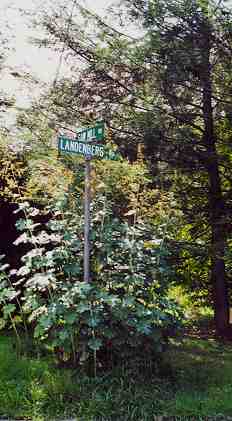
The intersection of Landenberg and Sawmill Roads, the beginning of the tour.
The New Garden Historical Commission conducted walking tours down Landenberg Road on Landenberg Day 2000, and again as part of the next summer's Chester County Village Walks. Buses took Landenberg Day participants from the village to the top of the hill at the intersection of Landenberg Rd. and Sawmill Rd. where the tour began. The buses had to go the long way around since the Landenberg Bridge was closed.

The intersection of Landenberg and Sawmill Roads, the beginning
of the tour.
The valley surrounding what is now the village of Landenberg was known as the "Wastelands" in the 1700's. The land surrounding the valley was all good farming land, and had all been cleared and plowed during that first century of Eurpoean settlement, but the steep sloped valley and ravines were fairly worthless agriculturally and had remained undeveloped.
In the early 1800's the success of the industrical revolution in New England led entrepreneurs all up and down the east coast to seek out and develop sources of waterpower. In the Wastelands, the White Clay Creek drops 60 feet in just about a mile. Over a period of twenty-five years from 1810 to 1835, Cadwalder Evands and Enoch Chandler surveyed and developed four dams to harness this power, harnessing just about every foot of drop in the valley. Eventually six mills were built to use the power from these dams. One of these mills was a grist mill, but most of them were wool spinning mills and were owned by Philadelphians textile manufacturers.
What is now considered to be Landenberg was originally two villages: Laurel and Chandlersville. Each of these villages sprung up around the early mills, Laurel around 1810 and Chandlersville araound 1820. The center of Chandlersville was right around the present Hotel and Store, and the center of Laurel was in the vicinity of Laurel Bridge, about 1/2 mile north of there.
Due to the rocky hillsides along the creek, it was initially very difficult to get from one village to the other, even though they are only 1/2 mile apart. In the early days of the villages, in order to get from one village to the other, one had to come up Landenberg Rd (then known as Chandlersville Rd) to the intersection with Sawmill Rd and then proceed down a now abandoned road back down to Laurel. The remenants of this road can still clearly be discerned in a cut through the woods going down to the stream. On the other side of the stream, the old road reappears as a private road for several houses that comes out on Penn Green Rd just north of Laurel Bridge.
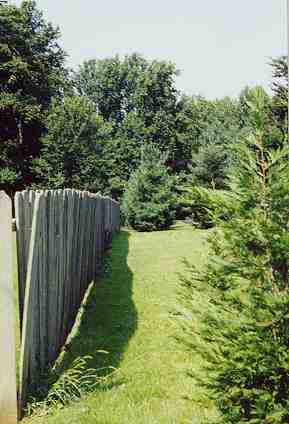
View looking north from the intersection of Landenberg and
Sawmill Roads, down the now abandoned road to Laurel.
In the 1840's a road connecting the two villages was built along the steep valley wall - this road is named Penn Green Rd today. There was no bridge at Laurel until the 1890's. Before that bridge was built, the road ended in a T intersection. To the left was the present Laurel Bridge Road (aka the Zig-Zag Road), and to the right (now the driveway to the new house overhanging the stream) went a steep road down to Laurel village and mills.
Landenberg obtained its name from Martin Landenberger, a German immigrant who started manufacturing stockings in 1843 on a single loom in Germantown, near Philadelphia. Through hard work (and being in a position to take advantage of a financial crisis in 1847 to buy a large quantity of wool very cheaply) his business expanded to the point where he had built a large factory in Germantown. In 1864, impressed with the amount of water power available at Laurel and Chandlersville, he purchased the wool spinning mills there and renamed the area Landenberg.
Most of the presently standing homes along Landenberg Road were built in the period immediatly after Martin Landenberger bought the town. At the foot of the hill were some tenament houses, and further up the hill were more substantial houses built for mill managers, better paid skilled workers, shop keepers, and other professionals.

Mrs. Mary McMahon donated a portion of the McMahon farm on the
corner of Sawmill and Landenberg Roads for this Catholic Church.
Building began in April, 1893, and was done chiefly by
parishoners. The pastor, Father John H. O'Donel, served both
Kennett and Landenberg until 1910. The first child baptized there
was Mary Connell, the first couple married there were William H.
Gardiner and Elizabeth Laurie. The painting of the crucifixion
that has always hung over the altar was restored to its original
state by artist Frank Schoonover.
The plain wooden chapel served the people of Landenberg and surrounding communities for seventy-two years. During that time, the number of Italian families living in the Avondale-Toughkenamon areas increased tremendously. The old building was inadequate in many ways - its benches were plain and its kneelers splintery; pigeons took up residence in the loft; it was cold in winter if you sat too far away from the centra furnace grate and too hot if you sat close by. It was no longer centrally located, and the wasps competed for attention on summer days when to windows were opened. It was replaced in 1966 by a new chapel, St. Gabriel's, on Rt. 41.
Today the church is home to ceramic artist Bernie Felch and his partner Roz DuPont who runs a rare-book business in one of the outbuildings.

142 Landenberg Rd - this home was originally the home of Kennedy
Crossan, the owner of the Sawmill which was located around the
corner on Sawmill Rd.
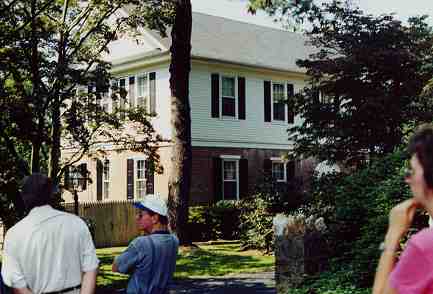
143 Landenberg Rd - this home was originally the 1875 Landenberg
School. This school closed in the 1930's when the schools were
consolidated. The building served as a tap room operated by
George Sharp, and then was turned into a home.

136 Landenberg Rd - Raymond Crossan, Jr.'s residence was
originally the Methodist parsonage.
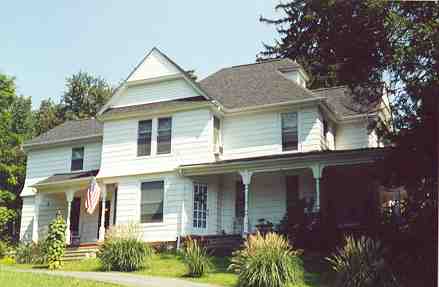
137 Landenberg Rd - originally the home of Ezra Lund, operator of
the Lund Mill. Ezra Lund, son of James Lund, was born in
Yorkshire, England in 1862 and immigrated to the Philadelphia to
join his father. Later the family moved to Landenberg, and
eventually took over the Landenberger Mills when Martin
Landenberger went bankrupt. Ezra Lund ran to company store (now
the Landenberg Store) for many years, and then took over the mill
itself when his father died.
In 1909, Ezra Lund's only son, 18-year old Ezra Lund, Jr., was killed just behind the barn when his gun discharged while returning from a hunting forary. Ezra was home from his studies at a military academy in Indiana, and was expected to follow in his father's and grandfather's footsteps and run the mill. It is possible that Ezra Jr.'s death was a part of the reason his father decided to close the mill a few years later.
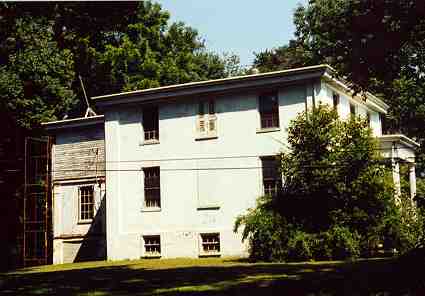
131 Landenberg Rd - this home was originally built around 1848
for Dr. James McClurg. a young medical doctor. He served as the
village doctor until 1858 when he moved to Philadelphia. He later
served in the Civl War, commanding serveral military hospitals,
before reestablishing himself in West Grove and later West
Chester.
The second owner of the house was Marshall Yeatman, who lived here from 1858 to 1864. He retired here after operating Yeatman's Mill, located near what is now the White Clay Creek Preserve Visitor's Center.
The third owner was Charles Weiler, son-in-law of Martin Landenberger. He moved here in 1864 to manage the Laurel and Chandlersville factories. He also served as an officer in the company that built the railroad to service Landenberg. He was remembered many years later for the splendor in which he lived, his coaches, his liveried coachman, and his butler. After the financial crash of 1873, he sold his property and moved back to Philadelphia.
It was on the lawn of this house that a gala celebration was held on October 19, 1872, when the Wilmington and Western Railroad arrived in Landenberg. Dignitaries arrived on the first train from Wilmington and were led up the hill by a brass band to hear speeches and partake of dinner.
The fourth owner was James Lund who purchased the Landenberg Mill and this home in 1880, after Martin Landenberger's bankruptcy. Born into a family of Yorkshire weavers and spinners, Lund immigrated to the U.S., in 1868. He lived here until his death when the house passed to his daughter and her husband, William W. Sullivan. W. Sullivan was the last owner of the Bone Mill; he was also a Justice of the Peace, postmaster, and owner of the Lumber and Coal yard at the bottom of the hill.
In 1920, the home was purchased by Joseph Sheehan. He and his brother Francis also purchased the Coal and Lumber business. Joseph died young in the 1940's, but his widow, Helen Sheehan, lived here until her death in the 70's. She served as Landenberg's post-mistress for many years.
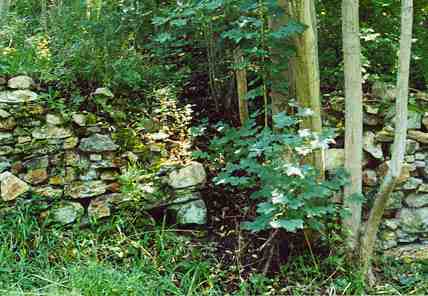
On the left-hand side of the road, a stone wall remains where
there was a large stone house which burned in the 1920's. Look
closely and you can see where the steps go up through the wall.
This may have been the location of the Lyceum building built by
Dr. James McClurg across from his house in the 1850's.
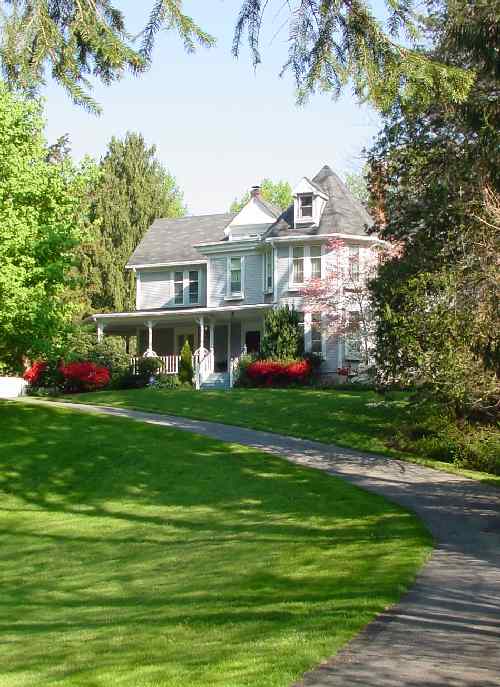
This home was originally built for Thomas Lund, son of James Lund
and brother of Ezra Lund. Thomas served as postmaster for a time.
The three Lund homes (this and the two homes immediately up the
hill) were known as "English Row".
In an 1874 article in the West Chester paper, it was written that much improvement was to be seen in the previous few years since Martin Landenberger had become the town proprietor, "Washington Ewing has also added materially to the growth of the place. The four new houses he has built are an ornament to the place. We can now boast of two stores where anything can be bought, from a paper of pins to a hundred dollar shawl or dress piece."
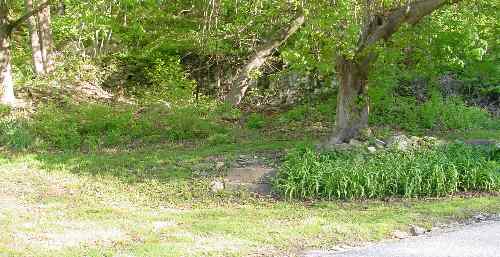
The tavern building was at an angle to the road, and in later
years was altered to become three homes. It burned in 1933. The
steps to the "hotel" can be still seen in the stone
wall, and the foundation wall can be seen under the trees.
The springhouse belonged to the hotel. After the demise of the hotel, George Harkins, a paperhanger, used to keep his paste here. On one occasion, Crossan's Great Dane ate the paste.
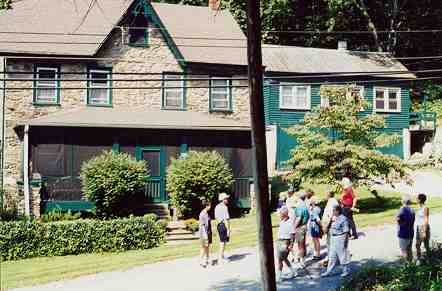
Washington Ewing's home and the carriage house for the hotel
property provided a place for horses and carriages.
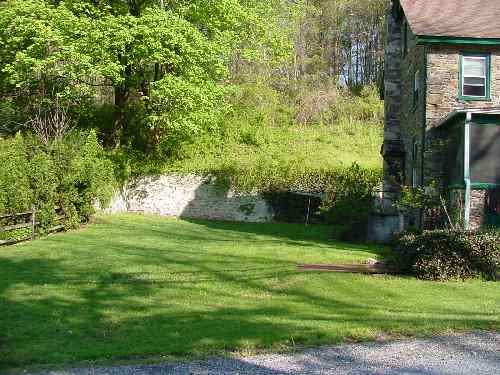
Washington Ewing operated a General Store from this site, the
back wall of which is still standing. The store was later owned
by A. A. Watson and then by John E. Kennedy.
On the left there is a new house up on the hill. This house replaces a gray frame house destroyed by fire that belonged to Fannie Fisher of the Fisher mill family. About 150 yards beyond the house, up in the woods, was a slaughterhouse.
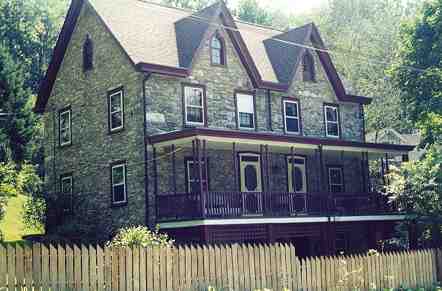
114 Gothic stone house, home in the of John and Katherine
LeFever.John LeFever was a train engineer.
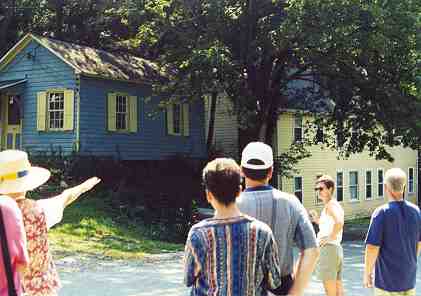
The small blue building was the post office in 1910. The post
office then moved to the south end of the long yellow building.
Later the post office returned to the blue building that also
housed the telephone exchange. In the post office there were open
pigeonholes for each families' mail. Death notices were sent in
black edged envelopes and always stirred curiosity when one was
spied in a neighbor's pigeonhole.

110 Landenberg Rd - the long yellow building, now apartments,
housed Sheehan Bros.' offices to the left of the post office. The
square window was above the scale and was the place where weight
receipts were handed out. Upstairs, the "good" lumber,
molding, etc., was stored. Sheehan Bros., was one of two
fair-sized businesses in Landenberg in the 20th century, the
other being the Crossan' s sawmill.
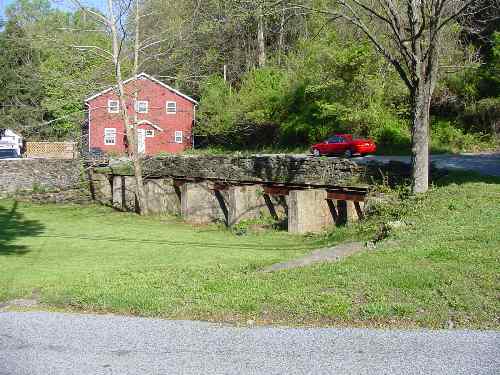
Richard B. Moore opened a lumber and coal yard here in 1874 and
operated it only for about three years before experiencing
financial difficulty due to falling lumber prices. He sold it to
James Lund, who operated the lumberyard successfully for several
years, and then sold it to Pusey and Wilson, who also operated a
yard in Avondale. William Sullivan and S. John Pyle later bought
the business and at the turn of the century were doing a thriving
business selling: lumber, coal, grain, feed, fertilizers, flour,
lime, plaster, and other building supplies.
One night in 1893, burglars hit multiple targets in Landenberg. The lumberyard office sustained major damage when the burglars blew open the safe and in the process blew out one wall of the building. All money in the safe was taken, and the drawer was afterwards discovered in the creek under the bridge. Amazingly, the night watchman at the mill nearby did not hear the explosion and raise the alarm. That same night the Landenberg Store was also broken into, as well as H. H. Storey's store and the Railroad Station.
In 1919 the lumberyard was sold to Joseph and Francis Sheehan. After their deaths in the 40's, the business was sold to Wilson and Brosius of Toughkenamon, who operated it as a branch of the Penn-Del Supply Co.
One can see the empty partitions for the coal bins of Sheehan's. The coal bins were part of a 3-storey building that enclosed the train track. The train cars would enter the building and then either dump coal or be unloaded of cement, lime, fertilizer, lumber, etc. The large wooden block along the driveway was part of one of the beams in this building.
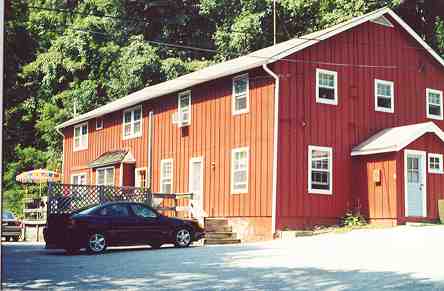
Wide boards and other lumber were stored in the red building. The
post office moved to the southeast end of the building in later
years and remained there until the current Landenberg post office
was built.
Enoch Chandler's grist mill was built on this side of the creek sometime before 1823. It was powered by the same dam that powered his textile mills on the far side of the White Clay. Enoch Chandler died in 1831, but before he died, he had agreed to sell his Cotton Mill and Fulling Mills on the far side of the creek to Thomas Walker of Christiana Hundred for $9000. Chandler was to retain the Gristmill and Walker agreed not to convert his mill to also operate as a gristmill.
The sales agreement contained provisions for sharing the dam between the two mill owners. In normal times Walker would get 2/3 of the water from the dam for the cotton and fulling mills and Chandler would get 1/3 of the water for the gristmill. In times of low water flow, the cotton mill was restricted to using water from 6am to 6pm. The grist mill would have use of the mill pond for the next 8 hours, and then the next four hours were for the fulling (felting) mill. Both parties agreed to refrain from erecting larger water wheels.
An advertisement in 1835, stated that there was a new sawmill attached to the gristmill. In 1858, a blacksmith shop and a wheelwright shop were also operating here.
The gristmill seems to have gone out of operation when the railroads came through in 1872, probably because the new tracks had cut off the millrace. The building was used for a while as a wool storage house, but was reported to be crumbling into ruins toward the end of the century.
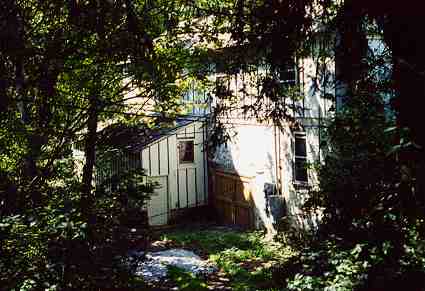
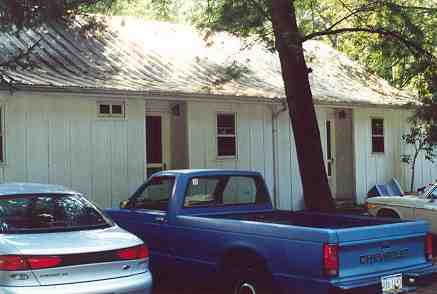
The Creamery - walk past the red lumber yard building and look at
the white building on the left. It was to the creamery where
farmers brought their milk to send to the city on the railroad.
Beyond the Creamery Site, in the grassy area between the pre-fab and the green building, was the Landenberg railroad station. This building was originally erected in Wilmington, than dismantled, moved to Landenberg, and rebuilt. Stand with your back to the site of the station and you will see ahead of you the level area where tracks of Wilmington and Western were. There was a ramp up to that level and a loading ramp for on and off loading of cattle.
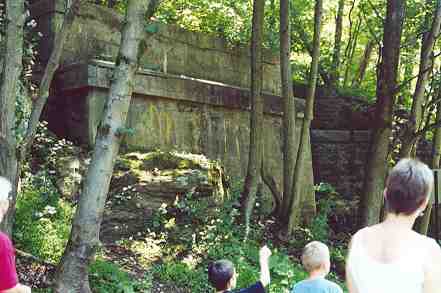
Two railroad tracks came into Landenberg from the south - The
Wilmington and Western and the Pomeroy and Delaware City Railway
Co. The abutments of two railroad bridges above Landenberg Rd
remain to show where they entered Landenberg.
Construction on the Wilmington and Western began in 1871. The line was run out along the Red Clay Creek to service the rolling mills, the spice mills, flour and sawmills, and a spoke factory. From there it went through the Hockessin Valley and into the White Clay watershed. Routes were surveyed as far west as Oxford, but Landenberg is as far as the railroad ever got.
The first run of the Pomeroy and Delaware City railroad was on July 3, 1873, and was marred by a collision with a cow. This railroad was set up from the beginning to be leased by the Pennsylvania Railroad Company, which put up half the capital for its construction and supplied its rolling stock when the railroad was put into operation. Martin Landenberger was a major shareholder in the company, having subscribed $500,000 out of the total of $2,500,000 of its construction. Two years later, by 1875, the Pennsylvania and Delaware City Railroad was bankrupt. Annual income was only a little over $6000 a year. The Pennsylvania Railroad Co purchased the bankrupt railroad for a bargain amount, and within the next few years traffic over the line increased markedly, but it was too late to help the initial shareholders.
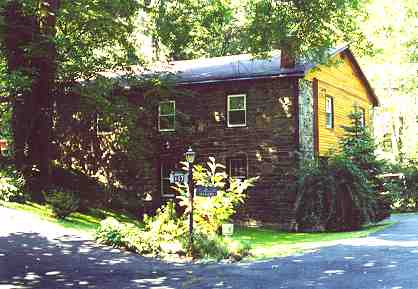
This building is thought to have been a machine shop for the
railroads. It is near the site of the earlier grist mill - a mill
stone was found buried beneath one of the walls of the building.
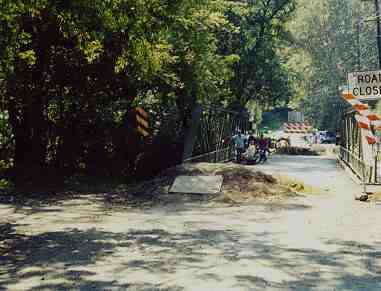
The Landenberg Bridge, a Pratt Pony Truss Bridge, was built in
1899 on stone abutments of an 1871 iron bridge and spans the
White Clay Creek. Although its stringers look like swiss cheese,
and its trusses show the effects of a 100 years of weathering,
the old bridge withstood the hurricane Floyd induced 500-year
flood. Today, despite being on the National Historic Register,
the bridge is threatened with demolition, a casualty to
"progress."
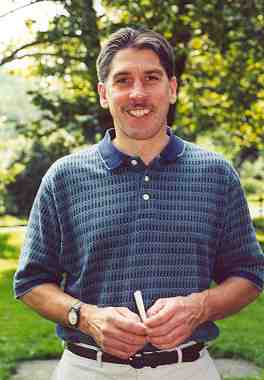
Tour guides included Tom Zawislak (above) and Dale Hendricks from the White Clay Watershed Association; Aileen Parrish of the London Britain Historical Commission; Landenberg Road resident Kelly Derr; and Pownall and Peg Jones of the New Garden Historical Commission.